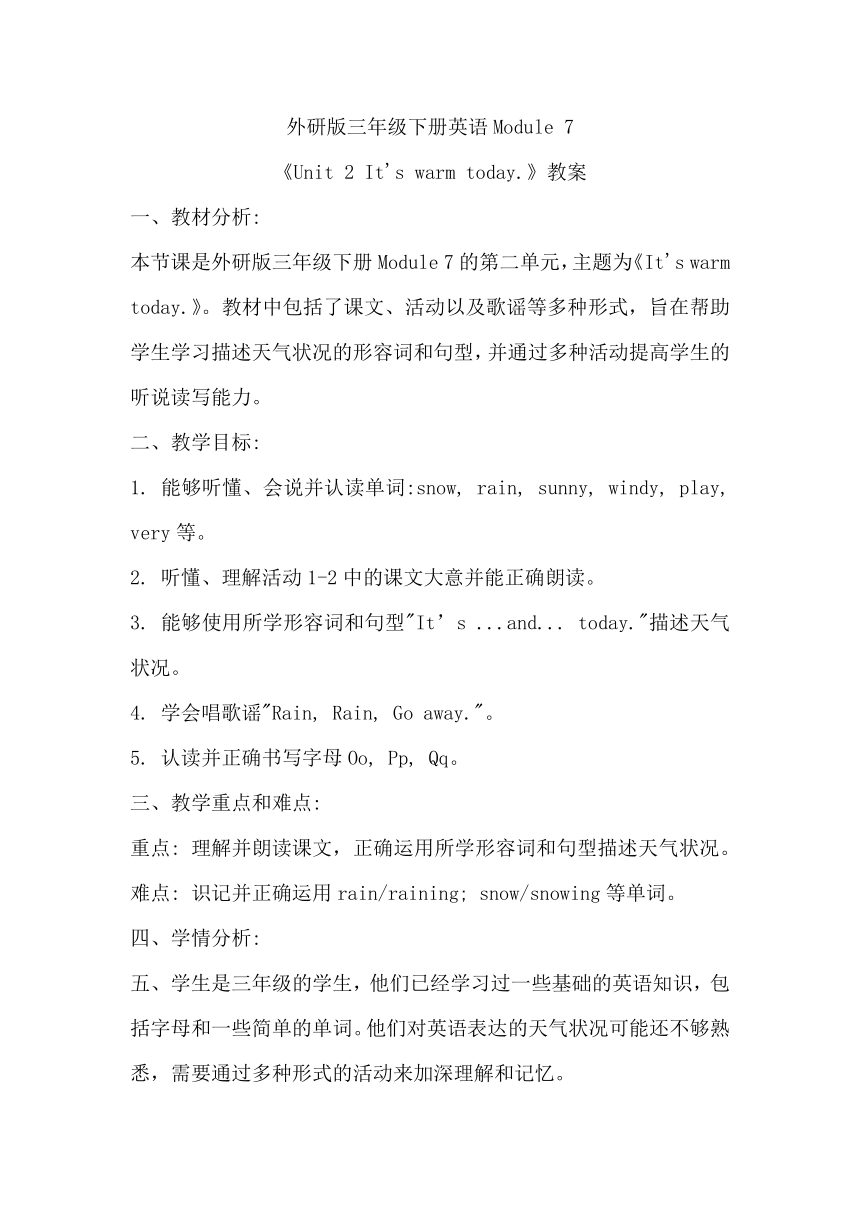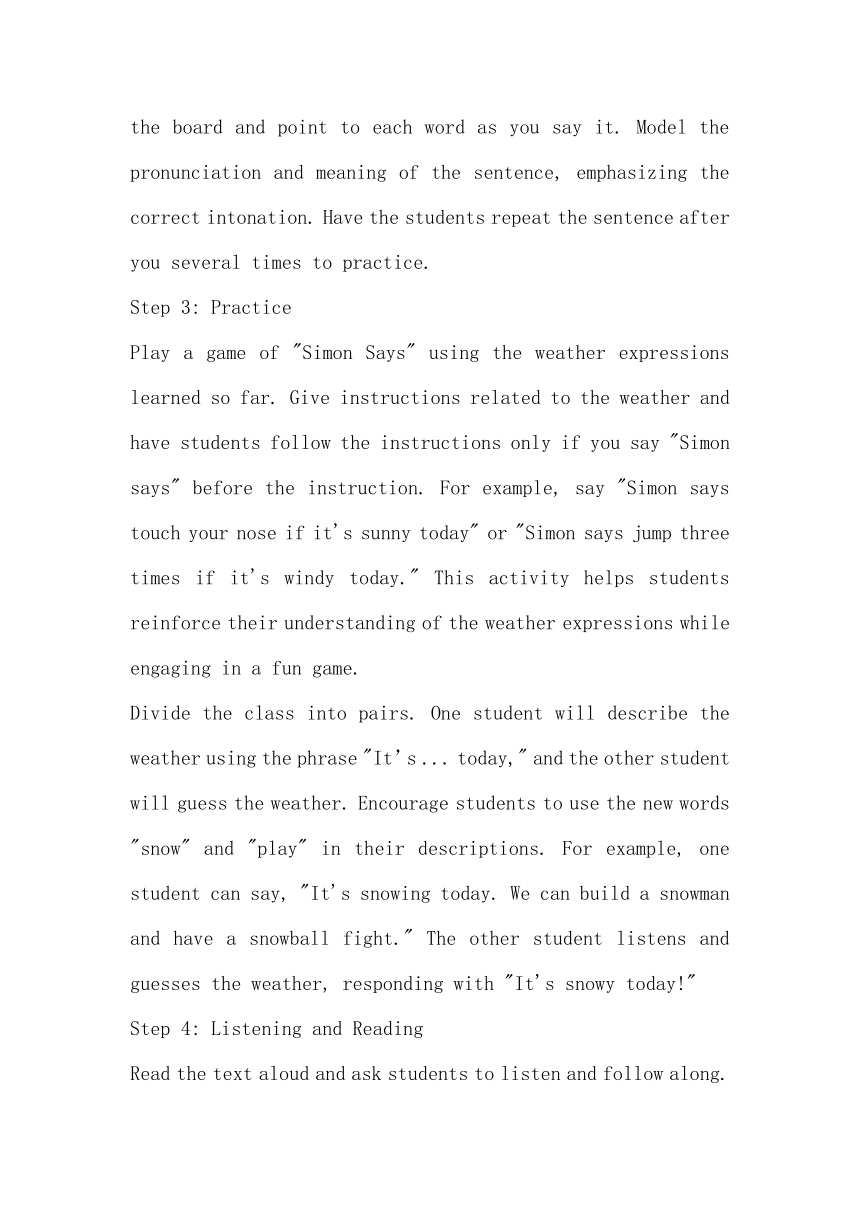Module 7 Unit 2 It's warm today.教案含反思
文档属性
| 名称 | Module 7 Unit 2 It's warm today.教案含反思 |

|
|
| 格式 | docx | ||
| 文件大小 | 14.9KB | ||
| 资源类型 | 教案 | ||
| 版本资源 | 外研版(三年级起点) | ||
| 科目 | 英语 | ||
| 更新时间 | 2024-02-03 19:48:16 | ||
图片预览



文档简介
外研版三年级下册英语Module 7
《Unit 2 It's warm today.》教案
一、教材分析:
本节课是外研版三年级下册Module 7的第二单元,主题为《It's warm today.》。教材中包括了课文、活动以及歌谣等多种形式,旨在帮助学生学习描述天气状况的形容词和句型,并通过多种活动提高学生的听说读写能力。
二、教学目标:
1. 能够听懂、会说并认读单词:snow, rain, sunny, windy, play, very等。
2. 听懂、理解活动1-2中的课文大意并能正确朗读。
3. 能够使用所学形容词和句型"It’s ...and... today."描述天气状况。
4. 学会唱歌谣"Rain, Rain, Go away."。
5. 认读并正确书写字母Oo, Pp, Qq。
三、教学重点和难点:
重点: 理解并朗读课文,正确运用所学形容词和句型描述天气状况。
难点: 识记并正确运用rain/raining; snow/snowing等单词。
四、学情分析:
学生是三年级的学生,他们已经学习过一些基础的英语知识,包括字母和一些简单的单词。他们对英语表达的天气状况可能还不够熟悉,需要通过多种形式的活动来加深理解和记忆。
教学过程
Step 1: Warm-up
Begin the class by greeting the students and reviewing the weather expressions learned in the previous class. Use visual aids such as flashcards or pictures to elicit the words "sunny," "windy," and "rainy." For example, hold up a flashcard with a picture of the sun and ask the students, "What's the weather like when we see this " Encourage students to respond using the word "sunny."
Ask the students to describe the weather today using these words. For example, you can say, "Today is ______ (pointing to the flashcard) weather. How do you feel about this weather "
Step 2: Presentation
Introduce the new words "snow" and "play" using visual aids such as flashcards or pictures. Show the flashcards one by one and pronounce the words clearly. Have the students repeat after you to practice pronunciation.
Show pictures or videos of snowing and children playing in the snow to help students understand the meaning of the words. Ask questions like, "What do you see in the picture " and "What do you think the children are doing "
Teach the phrase "It’s snowing today." Write the sentence on the board and point to each word as you say it. Model the pronunciation and meaning of the sentence, emphasizing the correct intonation. Have the students repeat the sentence after you several times to practice.
Step 3: Practice
Play a game of "Simon Says" using the weather expressions learned so far. Give instructions related to the weather and have students follow the instructions only if you say "Simon says" before the instruction. For example, say "Simon says touch your nose if it's sunny today" or "Simon says jump three times if it's windy today." This activity helps students reinforce their understanding of the weather expressions while engaging in a fun game.
Divide the class into pairs. One student will describe the weather using the phrase "It’s ... today," and the other student will guess the weather. Encourage students to use the new words "snow" and "play" in their descriptions. For example, one student can say, "It's snowing today. We can build a snowman and have a snowball fight." The other student listens and guesses the weather, responding with "It's snowy today!"
Step 4: Listening and Reading
Read the text aloud and ask students to listen and follow along. If available, play a recording of the text to help students with their listening comprehension. As you read, use gestures and facial expressions to make the text more engaging and comprehensible.
Have students read the text in pairs or small groups. Encourage them to take turns reading aloud, paying attention to the pronunciation and intonation. Circulate around the classroom, providing assistance and feedback as needed.
Step 5: Song
Introduce the song "Rain, Rain, Go away." Play the song and ask students to listen carefully. Sing along with the song to model the melody and rhythm.
Teach the lyrics line by line. Break down the lyrics and have the students repeat after you. Use gestures or actions to accompany the lyrics, making it more interactive. For example, for the line "Rain, rain, go away, come again another day," you can show raindrops falling with your fingers and then make a waving motion as if saying goodbye to the rain.
Sing the song together as a class. Encourage students to sing along and participate actively.
Step 6: Writing
Introduce the letters Oo, Pp, and Qq. Show the written forms of the letters on the board and explain their sounds. For example, for the letter Oo, write it in uppercase and lowercase and say, "This is Oo. It makes the sound /o/ like in 'open.'"
Practice writing the letters on the board and ask students to write them in the air or on their notebooks. Provide guidance and corrections as necessary.
Provide worksheets or activities for students to practice writing the letters. They can trace and write the letters multiple times to reinforce their letter recognition and formation.
Step 7: Wrap-up
Review the new words and phrases learned in the lesson. Ask students to describe the weather using the phrase "It’s ... today" and the new vocabulary. For example, you can say, "Tell me, what's the weather like today Use the phrase we learned."
Summarize the lesson by asking questions like, "What did we learn today " or "What can you say about the weather using the new words " Encourage students to actively participate and provide answers.
Preview the next lesson briefly, mentioning the topic or theme that will be covered in the following class.
六、板书设计:
Weather Expressions:sunny windy rainy snowy
Phrase: It’s ... today. It’s snowing today.
Letters: Oo Pp Qq
七、教学反思:
本节课主要围绕天气状况展开,通过多种形式的活动帮助学生学习相关的词汇、句型和字母。在教学过程中,我尽量采用了多样化的教学方法,包括口头练习、听力训练、游戏、歌曲和书写练习等,以激发学生的兴趣并提高他们的参与度。我注重了师生互动,鼓励学生多参与口语练习,并及时给予肯定和鼓励。同时,对于学生在识记和运用一些较难的单词时遇到的困难,我进行了针对性的辅导和指导,帮助他们克服难点。本节课的教学效果还是比较满意的。通过多种形式的活动,学生对天气状况的描述有了初步的掌握,并且对新学的单词和句型也有了一定的理解和运用能力。在后续的教学中,可以进一步拓展学生的应用能力,并加强对所学内容的复习和巩固。
《Unit 2 It's warm today.》教案
一、教材分析:
本节课是外研版三年级下册Module 7的第二单元,主题为《It's warm today.》。教材中包括了课文、活动以及歌谣等多种形式,旨在帮助学生学习描述天气状况的形容词和句型,并通过多种活动提高学生的听说读写能力。
二、教学目标:
1. 能够听懂、会说并认读单词:snow, rain, sunny, windy, play, very等。
2. 听懂、理解活动1-2中的课文大意并能正确朗读。
3. 能够使用所学形容词和句型"It’s ...and... today."描述天气状况。
4. 学会唱歌谣"Rain, Rain, Go away."。
5. 认读并正确书写字母Oo, Pp, Qq。
三、教学重点和难点:
重点: 理解并朗读课文,正确运用所学形容词和句型描述天气状况。
难点: 识记并正确运用rain/raining; snow/snowing等单词。
四、学情分析:
学生是三年级的学生,他们已经学习过一些基础的英语知识,包括字母和一些简单的单词。他们对英语表达的天气状况可能还不够熟悉,需要通过多种形式的活动来加深理解和记忆。
教学过程
Step 1: Warm-up
Begin the class by greeting the students and reviewing the weather expressions learned in the previous class. Use visual aids such as flashcards or pictures to elicit the words "sunny," "windy," and "rainy." For example, hold up a flashcard with a picture of the sun and ask the students, "What's the weather like when we see this " Encourage students to respond using the word "sunny."
Ask the students to describe the weather today using these words. For example, you can say, "Today is ______ (pointing to the flashcard) weather. How do you feel about this weather "
Step 2: Presentation
Introduce the new words "snow" and "play" using visual aids such as flashcards or pictures. Show the flashcards one by one and pronounce the words clearly. Have the students repeat after you to practice pronunciation.
Show pictures or videos of snowing and children playing in the snow to help students understand the meaning of the words. Ask questions like, "What do you see in the picture " and "What do you think the children are doing "
Teach the phrase "It’s snowing today." Write the sentence on the board and point to each word as you say it. Model the pronunciation and meaning of the sentence, emphasizing the correct intonation. Have the students repeat the sentence after you several times to practice.
Step 3: Practice
Play a game of "Simon Says" using the weather expressions learned so far. Give instructions related to the weather and have students follow the instructions only if you say "Simon says" before the instruction. For example, say "Simon says touch your nose if it's sunny today" or "Simon says jump three times if it's windy today." This activity helps students reinforce their understanding of the weather expressions while engaging in a fun game.
Divide the class into pairs. One student will describe the weather using the phrase "It’s ... today," and the other student will guess the weather. Encourage students to use the new words "snow" and "play" in their descriptions. For example, one student can say, "It's snowing today. We can build a snowman and have a snowball fight." The other student listens and guesses the weather, responding with "It's snowy today!"
Step 4: Listening and Reading
Read the text aloud and ask students to listen and follow along. If available, play a recording of the text to help students with their listening comprehension. As you read, use gestures and facial expressions to make the text more engaging and comprehensible.
Have students read the text in pairs or small groups. Encourage them to take turns reading aloud, paying attention to the pronunciation and intonation. Circulate around the classroom, providing assistance and feedback as needed.
Step 5: Song
Introduce the song "Rain, Rain, Go away." Play the song and ask students to listen carefully. Sing along with the song to model the melody and rhythm.
Teach the lyrics line by line. Break down the lyrics and have the students repeat after you. Use gestures or actions to accompany the lyrics, making it more interactive. For example, for the line "Rain, rain, go away, come again another day," you can show raindrops falling with your fingers and then make a waving motion as if saying goodbye to the rain.
Sing the song together as a class. Encourage students to sing along and participate actively.
Step 6: Writing
Introduce the letters Oo, Pp, and Qq. Show the written forms of the letters on the board and explain their sounds. For example, for the letter Oo, write it in uppercase and lowercase and say, "This is Oo. It makes the sound /o/ like in 'open.'"
Practice writing the letters on the board and ask students to write them in the air or on their notebooks. Provide guidance and corrections as necessary.
Provide worksheets or activities for students to practice writing the letters. They can trace and write the letters multiple times to reinforce their letter recognition and formation.
Step 7: Wrap-up
Review the new words and phrases learned in the lesson. Ask students to describe the weather using the phrase "It’s ... today" and the new vocabulary. For example, you can say, "Tell me, what's the weather like today Use the phrase we learned."
Summarize the lesson by asking questions like, "What did we learn today " or "What can you say about the weather using the new words " Encourage students to actively participate and provide answers.
Preview the next lesson briefly, mentioning the topic or theme that will be covered in the following class.
六、板书设计:
Weather Expressions:sunny windy rainy snowy
Phrase: It’s ... today. It’s snowing today.
Letters: Oo Pp Qq
七、教学反思:
本节课主要围绕天气状况展开,通过多种形式的活动帮助学生学习相关的词汇、句型和字母。在教学过程中,我尽量采用了多样化的教学方法,包括口头练习、听力训练、游戏、歌曲和书写练习等,以激发学生的兴趣并提高他们的参与度。我注重了师生互动,鼓励学生多参与口语练习,并及时给予肯定和鼓励。同时,对于学生在识记和运用一些较难的单词时遇到的困难,我进行了针对性的辅导和指导,帮助他们克服难点。本节课的教学效果还是比较满意的。通过多种形式的活动,学生对天气状况的描述有了初步的掌握,并且对新学的单词和句型也有了一定的理解和运用能力。在后续的教学中,可以进一步拓展学生的应用能力,并加强对所学内容的复习和巩固。
同课章节目录
- Module 1
- Unit 1 It's the ABC song.
- Unit 2 My favourite colour is yellow.
- Module 2
- Unit 1 They are monkeys.
- Unit 2 The man is short.
- Module 3
- Unit 1 I like football.
- Unit 2 I don't like riding my bike.
- Module 4
- Unit 1 Do you like meat?
- Unit 2 Does Lingling like oranges?
- Module 5
- Unit 1 She goes to school on Mondays.
- Unit 2 Does your mum go to work on Saturdays?
- Module 6
- Unit 1 What do you do on Sundays?
- Unit 2 What does Lingling have at school?
- Module 7
- Unit 1 We fly kites in spring.
- Unit 2 It's warm today.
- Module 8
- Unit 1 It's on your desk.
- Unit 2 Daming flies a kite in the park.
- Module 9
- Unit 1 I've got a new book.
- Unit 2 Has Amy got a bike?
- Review Module
- Unit 1
- Unit 2
- Module 10
- Unit 1 Here's a red hat.
- Unit 2 She's got an orange sweater.
